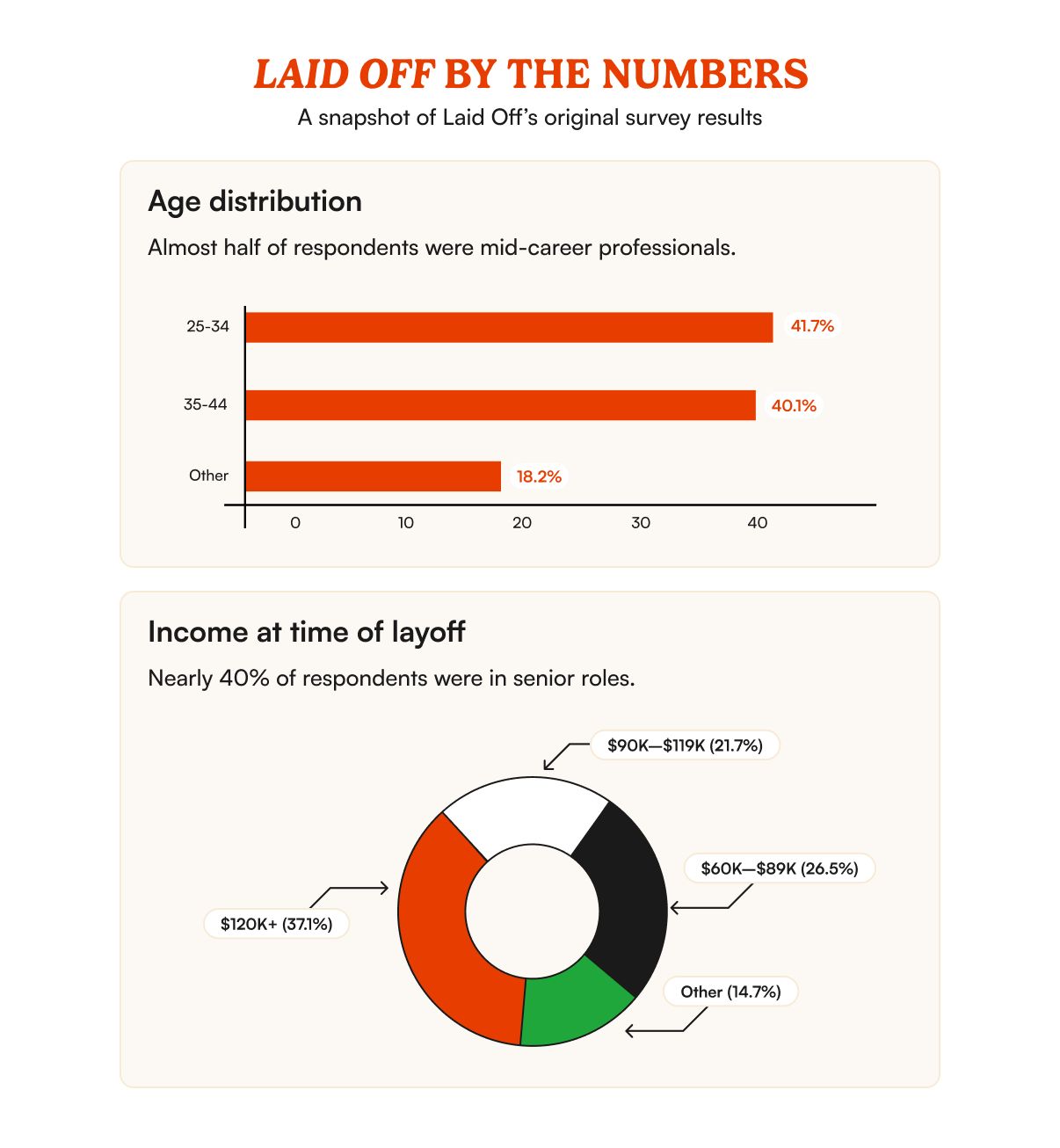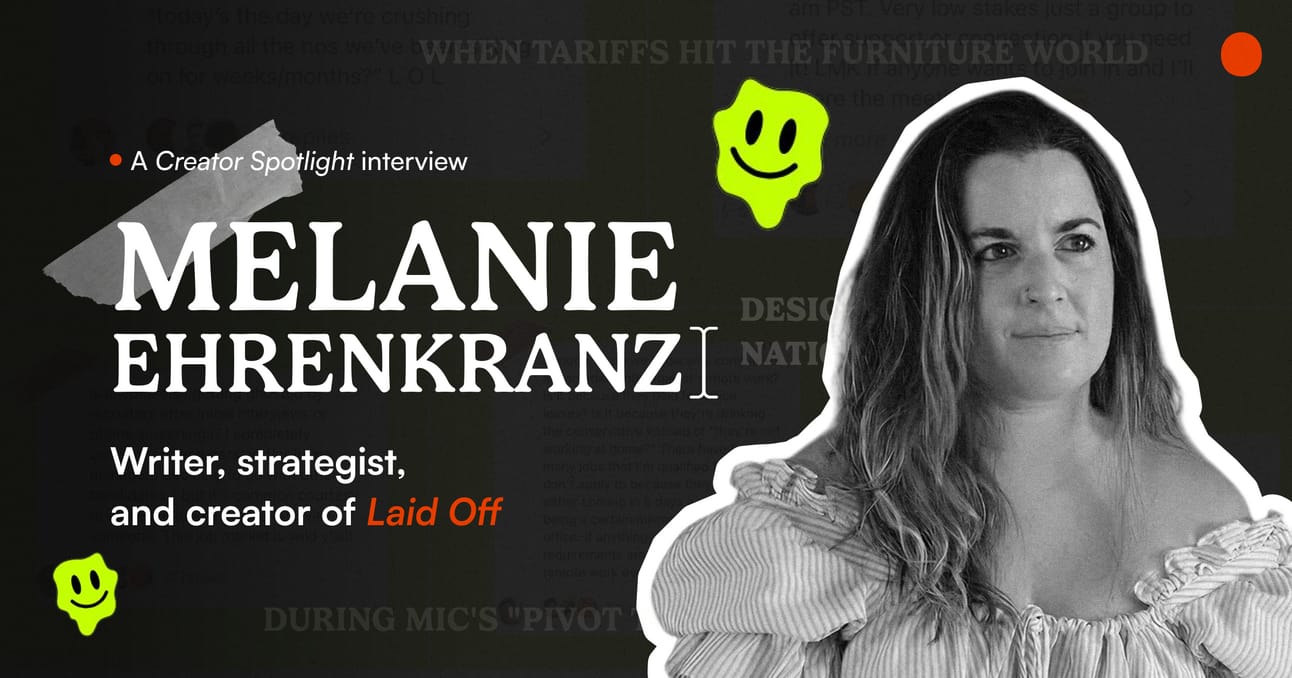In partnership with:
How do you monetize a newsletter when your primary audience just lost their jobs?
Our guest this week is Melanie Ehrenkranz, a writer, strategist, and creator of Laid Off, a newsletter and Discord community with over 10,000 subscribers and 850+ active members, respectively.
She launched the project a year after getting laid off herself, creating a blend of journalism and mutual aid that turns job loss into collective power. Through her editorial lens, the platform quickly became an empathetic, cathartic support system that's both financially sustainable and genuinely helpful to its community.
In this episode:
📧 How a viral survey launched a 10K+ subscriber newsletter
👥 Building revenue without exploiting a financially vulnerable audience
☕ Choosing brand partnerships that meet your audience’s needs
— Natalia Pérez-González, Assistant Editor
P.S. We’re curious, which creator-led communities are you a part of? How’ve they been most impactful to you? Leave us your thoughts in the comments. We’ll respond to each one!

Burnout isn’t a badge of honor
You didn’t start your creator business to be exhausted all the time.
But somewhere between the algorithm changes, content treadmill, and trying to monetize your passion — you burned out. And no one told you this:
Hustle is not a business model.
Burnout isn’t proof you’re doing it right.
And building something big shouldn’t break you.
That’s where The Creator Summit comes in.
It’s a free, 3-day virtual event (June 24–26) packed with honest conversations and actionable strategies from creators who’ve stopped chasing trends and started building on their own terms.
You’ll walk away with a clear plan to build something that actually works for you.

00:00 Introducing Melanie
01:44 How Laid Off began
06:32 Building an engaged, valuable community
10:12 Trend reports and insights from the laid-off experience
13:20 Monetization that gives back to the community
22:47 LinkedIn culture and the need for a personal brand
30:36 Potential future services for Laid Off
35:48 Permeable definitions of “creator”
39:56 The creativity of the newsletter format
42:28 The laid-off to creator pipeline
49:01 How to gain your first 10K subscribers
51:26 One year of Laid Off
🎧 If you prefer a podcast platform other than YouTube, we’re on anywhere you tune in to your podcasts.

A layoff community built from necessity
Melanie Ehrenkranz is building a newsletter and community billed as “the coolest place in the world to talk about being laid off,” and it all started with a LinkedIn survey and a moment of personal reflection.
"I caught myself wondering, how are they doing? What was their experience like? I never really talked to my friends who'd been laid off about the weeks, the months, the year after."
She posted the survey at 10 p.m., expecting maybe a few dozen responses about people's layoff experiences.
Within days, she had 500 responses. People weren't just filling out demographic questions; they were also writing essays in the "anything else to add" section, using words like "cathartic," "therapeutic," and even "fun" to describe the experience of finally talking about their layoffs. Most surprising: they weren't hiding behind anonymity. They gave their names, companies, and most vulnerable details, completely comfortable with Melanie sharing their stories.

That survey became the launchpad for Laid Off, and Melanie’s approach defied conventional wisdom about building a creator business. Her project has all the infrastructure of creator journalism — paid subscriptions, brand partnerships, and a Discord community. Yet, she doesn't gatekeep content, doesn’t prioritize revenue, and isn’t actively the face of the brand.
Instead, she built something more essential: a communal venue where the laid-off can process their disappointment and connect with others who understand their experiences. Her newsletter has grown steadily to over 10,000 subscribers, and when DOGE launched its campaign to downsize the federal workforce earlier this year, Melanie was perfectly positioned to document stories from affected federal workers.
“I interviewed five people and did a homepage takeover for a week where I just featured federal workers. It felt like I was running a newspaper, and I was so proud to be able to show this cultural, political, historic moment through the lens of layoffs.”
Her adjoining Discord community, available to subscribers for an additional monthly fee, currently supports 850 members who share job rejections, offer career guidance, and organize meetups across channels. It's become genuine mutual aid; only about 150 people pay her $5 monthly subscription, and Melanie deliberately gives away hundreds of free Discord invites to anyone who needs community support.
While Melanie works full-time as head of content and community at Business Class, she dedicates nights and weekends to Laid Off. Her growing community has garnered coverage from The New York Times and established something rare in the creator economy: a platform that prioritizes its audience first and monetizes second.
"I consider myself the facilitator," Melanie says. "There are many faces of Laid Off." It's this perspective — treating community as the product, not the customer — that's made Laid Off essential reading for anyone navigating the instability of today’s workforce.

Nat’s notes ✍️
A few things that stuck with me as I listened through this week’s conversation:
Melanie’s creator business relies on vulnerability. Most creator businesses rely on aspiration — be like me, buy what I’m selling, achieve what I’ve achieved. Melanie built the opposite: a space where professional failure is the entry point to connection. It runs counter to every growth hack or audience-building strategy you typically hear, and yet, it’s created one of the most engaged and loyal communities I’ve seen.
Her resistance to calling herself a “creator.” If you’ve tuned in to enough Creator Spotlight episodes, you know our editor, Francis, always asks our guests for their definition of “creator”. Melanie shared hers, but noted that she doesn’t feel like she qualifies as one, since she’s not the face of the brand and doesn’t create video content about it.
It got me thinking about how our definitions of “creator” are still evolving, and how often they’re tangled up with our assumptions about visibility and influence. (For the record: we definitely consider Melanie a creator.)


How to partner with brands without selling out your community
Most newsletter ads ask readers to spend money. Melanie's sponsors give readers money to spend.
Her signature sponsorship, "Coffee on Me,” is one of the smartest brand alignment tactics we've seen in the newsletter space. A brand pays to sponsor an edition of Laid Off, and that sponsorship includes funding for ten $10 coffee gift cards that go directly to readers. Anyone who opens the email within 24 hours gets entered to win.
She keeps sponsorship prices affordable so that solo creators, newsletterists, and other brands aligned with mutual aid can easily participate.

The gift is financially small, but the benefits are threefold:
For readers: A genuine moment of delight — the digital equivalent of a friend Venmo-ing you for coffee after a rough day; the brand becomes the friend
For brands: A halo effect from supporting an engaged but vulnerable audience, with visibility in a highly engaged community
For Melanie: A sustainable, value-aligned revenue stream that doesn't compromise her mission, with added incentive for her audience to open each newsletter immediately after receiving it
This tactic also strengthens the newsletter's identity. It transforms brand involvement into something readers actively anticipate, rather than tolerate, and makes way for Melanie to give back to her community without extracting from it.
How to apply this partnership model to your business
If you're a creator with a niche audience and a strong sense of mission, consider this your blueprint. Don't just think about CPMs or click-through rates — think about how your sponsors can show up for your audience. Design experiences that feel generous, relevant, and real:
For job seekers, it's coffee
For new parents, meal delivery might be a helpful option
For students, perhaps bookstore credits
For caregivers, grocery delivery vouchers
The specific offering matters less than the authentic connection between the sponsor's value and the audience's need. Ultimately, it’s about building partnerships that strengthen, support, and elevate your community.

How to shorten the path between your ideas and audience (Creator Spotlight)
This creator-founder brought in 5,000 new signups with this video (TikTok)
10 myths to dispel when building a community (thinking out loud)



